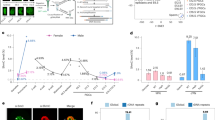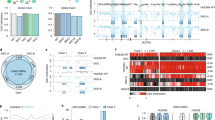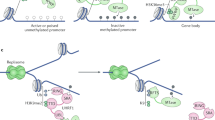Abstract
After erasure in the early animal embryo, a new bimodal DNA methylation pattern is regenerated at implantation. We have identified a demethylation pathway in mouse embryonic cells that uses hydroxymethylation (Tet1), deamination (Aid), glycosylation (Mbd4) and excision repair (Gadd45a) genes. Surprisingly, this demethylation system is not necessary for generating the overall bimodal methylation pattern but does appear to be involved in resetting methylation patterns during somatic-cell reprogramming.
This is a preview of subscription content, access via your institution
Access options
Subscribe to this journal
Receive 12 print issues and online access
$189.00 per year
only $15.75 per issue
Buy this article
- Purchase on Springer Link
- Instant access to full article PDF
Prices may be subject to local taxes which are calculated during checkout


Similar content being viewed by others
Accession codes
References
Brandeis, M. et al. Nature 371, 435–438 (1994).
Macleod, D., Charlton, J., Mullins, J. & Bird, A.P. Genes Dev. 8, 2282–2292 (1994).
Stadler, M.B. et al. Nature 480, 490–495 (2011).
Straussman, R. et al. Nat. Struct. Mol. Biol. 16, 564–571 (2009).
Frank, D. et al. Nature 351, 239–241 (1991).
Guo, J.U., Su, Y., Zhong, C., Ming, G.L. & Song, H. Cell 145, 423–434 (2011).
Cortellino, S. et al. Cell 146, 67–79 (2011).
Battulin, N.R. et al. Cell Tissue Res. 337, 439–448 (2009).
Freberg, C.T., Dahl, J.A., Timoskainen, S. & Collas, P. Mol. Biol. Cell 18, 1543–1553 (2007).
Gidekel, S. & Bergman, Y. J. Biol. Chem. 277, 34521–34530 (2002).
Keshet, I. et al. Nat. Genet. 38, 149–153 (2006).
Antequera, F., Boyes, J. & Bird, A. Cell 62, 503–514 (1990).
Bhutani, N. et al. Nature 463, 1042–1047 (2010).
Kumar, R. et al. Nature 500, 89–92 (2013).
Nabel, C.S. et al. Nat. Chem. Biol. 8, 751–758 (2012).
Ito, S. et al. Science 333, 1300–1303 (2011).
Rusmintratip, V. & Sowers, L.C. Proc. Natl. Acad. Sci. USA 97, 14183–14187 (2000).
He, Y.F. et al. Science 333, 1303–1307 (2011).
Maiti, A. & Drohat, A.C. J. Biol. Chem. 286, 35334–35338 (2011).
Zhang, L. et al. Nat. Chem. Biol. 8, 328–330 (2012).
Jung, H.J. et al. Oncogene 26, 7517–7525 (2007).
Hackett, J.A. & Surani, M.A. Phil. Trans. R. Soc. Lond. B 368, 20110328 (2013).
Valinluck, V. & Sowers, L.C. Cancer Res. 67, 946–950 (2007).
Hashimoto, H. et al. Nucleic Acids Res. 40, 4841–4849 (2012).
Rai, K. et al. Cell 135, 1201–1212 (2008).
Williams, K. et al. Nature 473, 343–348 (2011).
Wu, H. et al. Nature 473, 389–393 (2011).
Mayer, W., Niveleau, A., Walter, J., Fundele, R. & Haaf, T. Nature 403, 501–502 (2000).
Reynaud, C. et al. Cancer Lett. 61, 255–262 (1992).
Meissner, A. et al. Nature 454, 766–770 (2008).
Acknowledgements
Knockout Aid− and Mbd4− ES cells were obtained from T. Honjo (Kyoto University) and A. Bird (Edinburgh University), respectively. Tissue DNA from Aid− and Mbd4− mice was obtained from W. Reik (Cambridge University) and A. Bird (Edinburgh University), respectively. This research was supported by US National Institutes of Health grant 5R01GM062275 (H.C.), European Research Council grant ERCGA268614 (H.C.), Israeli Centers Of Research Excellence grant 41/11 (H.C.), Israel Cancer Research Foundation grant 210910 (H.C.) and Israel Science Foundation grant 419/10 (H.C.).
Author information
Authors and Affiliations
Contributions
O.S., A.Z. and I.K. carried out the experiments and did most of the data analysis; I.K. provided invaluable input and expertise; M.H. and A.T. contributed to the experiments; G.L. carried out the mDIP microarray experiments; J.M. analyzed bioinformatic data; H.C. wrote the manuscript, generated the main concepts and was responsible for project design and interpretation of all experiments.
Corresponding author
Ethics declarations
Competing interests
The authors declare no competing financial interests.
Integrated supplementary information
Supplementary Figure 1 Demethylation of CpG islands in ES cells.
Wt or genetically-modified ES cells were co-transfected with the in vitro HpaII-HhaI methylated CpG island sequences ChTk, hAprt, GAPDH, HSP (a) or mouse Pou5f1 (b). Stable colonies were pooled and DNA subjected to bisulfite analysis to determine percent methylation remaining at pre-methylated sites. Gadd45kd ES cells show considerable variation in the degree of CpG island demethylation. Nonetheless, statistical analysis indicated that, in general, these cells were deficient in demethylation as compared to the wt (P < 0.003) (Supplementary Fig. 3). It should be noted that the Pou5f1 vector has the same sequence as the endogenous gene, and cannot be distinguished in the bisulfite analyses. Since the endogenous sequence is completely unmethylated in ES cells methylation scores above ~ 40% indicate that the vector sequences did not undergo demethylation in most mutant cells. Sample single-molecule bisulfite analyses of HSP before (in vitro) and after transfection into wt and mutant ES cells (c). CpG sites marked with gray circles were not methylated in the original vector, but became de novo methylated after transfection into ES cells.
Supplementary Figure 2 Characterization of WT and knockdown ES cells.
(a) Statistical analysis. Pre-methylated or unmethylated templates transfected into wt or defective ES cells were assayed for methylation (±SD) (data from Fig. 1 and Supplementary Fig. 1). Similar comparison was carried out for fusions between Ltk– cells carrying the premethylated hAprt and ChTk CpG islands (Fig. 2). P values (Student's T-test) are shown for each comparison. The number (n) of independent experiments carried out in each cell type is shown in parentheses. (b) The relative endogenous mRNA levels of Tet1, Gadd45a, Mbd4 and Aid in wt ES. (c) ES knockdowns were generated by stable transfection with shRNA (Open Biosystem), and single colonies then isolated and subjected to RT-PCR and Western analysis in order to select clones with the lowest activity. mRNA levels in the knockdown cells are compared to those in wt cells. (d) The Western blot was carried out using anti Tet1 and β Actin antibodies were obtained from Millipore and Sigma, respectively.
Supplementary Figure 3 Protection from de novo methylation in ES cells.
(a) Single-molecule Bisulfite analysis for a sample of unmethylated templates transfected into wt and mutant ES cells. Note that HSP is a CpG island sequence that is unmethylated in ES cells, while the endogenous DAZ1 and CRYAA sequences are normally methylated in ES cells. (b) Liver, spleen and ES cell DNA from wt, Aid– and Mbd4– mice was subjected to mDIP microarray analysis covering all CpG islands in the mouse genome. The bimodal CpG island distribution was graphed as a function of island methylation score (IMS). Note that in wt DNA, a large percentage of islands are unmethylated, and this is the same in DNA from mutant mice. mDIP was performed as described1 and analyzed on a mouse (105 k) CpG island microarray (Agilent Technology). IMS was calculated by averaging the Z-scores of multiple probes in each island and the data validated by comparison to published bisulfite sequencing of mouse ES cell DNA2. (c) Single-molecule Bisulfite analysis for a sample (A-D) of endogenous methylation-prone CpG islands (Supplementary Fig. 5) in Tet1kd ES cells.
Supplementary Figure 4 Demethylation is required for methylation reprogramming.
(a) Single-molecule bisulfite methylation analysis of Pou5f1 and Nanog in Ltk– × ES cell fusions. Note that these endogenous genes are unmethylated in demethylation-deficient ES cell lines, as well. (b) Pluripotency markers Sox2 and Rex1. Sox2 transcription levels as determined by RT-PCR in wt and Aidkd ES cells fused with Ltk– cells. Note that both ES cell types express high levels of these genes. Following fusion with wt ES cells, the pluripotency markers remain high, but are dramatically reduced in Aidkd fusions. Similar results were obtained for fusions using other demethylation-deficient ES cells, as well. The level of these genes in feeder layer cells (STO) is shown as a control. It should be noted that Pou5f1 and Nanog appear to be highly methylated in almost all of the demethylation-deficient fused cells, suggesting that the original unmethylated (Supplementary Fig. 5c) ES-cell copies of these pluripotency-gene promoters may have undergone some de novo methylation, unlike other CpG islands (e.g. Hsp) in the mouse genome (Fig. 2 and Supplementary Fig. 5). One explanation for this effect may be that in the absence of successful reprogramming, the fibroblast nucleus acts in a dominant manner to bring about differentiation of the embryonic nucleus with subsequent inactivation and de novo methylation of its pluripotency genes3.
Supplementary Figure 5 Reprogramming of abnormally methylated CpG islands.
Single-molecule bisulfite analysis was carried out on 5 CpG islands that are highly methylated in the Ltk– fibroblast cell line but not in normal tissues (data not shown). Note that these islands all undergo complete demethylation when fused to ES cells but not in demethylation-defective mutants. Hsp serves as a control for CpG islands unmethylated in Ltk– cells, while Cryaa, Gcg and Ins2 serve as a control for regions normally methylated in both ES and Ltk– cells.
Supplementary information
Supplementary Text and Figures
Supplementary Figures 1–5 (PDF 2742 kb)
Supplementary Table 1
Primer and coordinate list (XLSX 41 kb)
Rights and permissions
About this article
Cite this article
Sabag, O., Zamir, A., Keshet, I. et al. Establishment of methylation patterns in ES cells. Nat Struct Mol Biol 21, 110–112 (2014). https://doi.org/10.1038/nsmb.2734
Received:
Accepted:
Published:
Issue Date:
DOI: https://doi.org/10.1038/nsmb.2734
This article is cited by
-
'Memory and molecular turnover,’ 30 years after inception
Epigenetics & Chromatin (2014)



